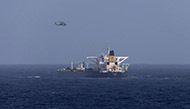▶ JOE NOCERA
The quest began in 2005, when Sachs, who directs the Earth Institute at Columbia University, started an ambitious program called the Millennium Villages Project. He and his team chose a handful of sub-Saharan African villages, where they imposed a series of “interventions” in such areas as agriculture, health and education. The idea was that these villages would show Africa — and the world — how the continent could loosen the grip that extreme poverty had on so many of its people.
From the start, the Millennium Villages Project has been controversial. It has soaked up large sums of money — the original seed money was $120 million — which its critics believe could have been better used on more targeted, less grandiose forms of aid. Because Sachs, for years, refused — on ethical grounds, he said — to rigorously compare the results at his villages with villages that didn’t get the same kind of help, development experts complained that there was no way of knowing if the project was making a difference.
“There is zero scientific evidence that the Millennium Villages Project is meetings its goals,” says Michael Clemens, a senior fellow at the Center for Global Development and a leading Sachs critic. Sachs, for his part, insists that the Millennium Villages Project has been a roaring success, so much so that its interventions are now being imitated — “scaled up” — in nations like Uganda, with full government support.
It is not quite right to say that Nina Munk has sidestepped the dispute between Sachs and his critics. Mainly, though, she has looked at the Millennium Villages Project through a different lens. She has spent the last half-dozen years traveling back and forth to Africa, to see for herself how the Sachs experiment was unfolding. She focused in particular on two villages: Dertu, Kenya, and Ruhiira, Uganda.
“Jeff is a charismatic man, and I wanted to believe in him,” Munk told me recently. (She and I overlapped at Fortune for several years.) She is quick to give him credit where it is due: for instance, his passionate advocacy for free distribution of insecticide-coated bed nets, at a cost of hundreds of millions of dollars, is an important reason that the scourge of malaria is being reduced. But her reporting also caused her to become disillusioned, and humbled, by the difficulties that any Western aid effort is likely to encounter.
With almost every intervention, she documents the chasm that exists between the villagers and those running the project. At one point, the Millennium Villages Project persuades the farmers in Ruhiira to grow maize instead of their traditional crop, called matoke. “The results were fantastic,” she reports, a bumper crop. Except there were no buyers for the maize, so most of it wound up being eaten by rats. In Dertu, Sachs’s staff decided it should set up a livestock market. It flopped. Efforts to convince villagers to start small businesses largely failed. The critical problem of getting clean water to the villages was enormously expensive.
Ultimately, reports Munk, Dertu was abandoned by the Millennium Villages Project while Ruhiira is today lauded as one of the project’s most successful villages. “There is no question the lives of people in Ruhiira have been improved,” Munk told me. “I’ve seen it.” But she is dubious about what that means — other than the fact that if you pump millions of dollars into an isolated African village, the villagers’ lives will be better. (Sachs’s defenders say that most of her reporting was done before the project really found its footing.)And there’s the rub. Sachs has always aimed higher than helping a handful of villages. He wants to put his imprint on all of Africa. When I spoke to him recently, he claimed that is exactly what has been happening, thanks to more than $100 million in loans from the Islamic Development Bank. But when I looked at the press release announcing the “scale up” in Uganda, the money involved was less than $10 million — a pittance, really, and unlikely to transform the country.
That things in Africa are getting better is undeniable. Child mortality is down, as is the number of people living in extreme poverty. In his book, “Emerging Africa,” Steve Radalet, the former chief economist for the United States Agency for International Development, gives credit to such factors as more democratic governments, a new class of civil servants and businesspeople, and sounder economic policies. Sachs, on the other hand, wants us to believe that the main driver has been the Millennium Villages Project, which has shown the way.
“The Idealist” makes it tough to believe it’s the latter
스마터리빙
more [ 건강]
[ 건강]이제 혈관 건강도 챙기자!
[현대해운]우리 눈에 보이지 않기 때문에 혈관 건강을 챙기는 것은 결코 쉽지 않은데요. 여러분은 혈관 건강을 유지하기 위해 어떤 노력을 하시나요?
 [ 건강]
[ 건강]내 몸이 건강해지는 과일궁합
 [ 라이프]
[ 라이프]벌레야 물럿거라! 천연 해충제 만들기
 [ 건강]
[ 건강]혈압 낮추는데 좋은 식품
[현대해운]혈관 건강은 주로 노화가 진행되면서 지켜야 할 문제라고 인식되어 왔습니다. 최근 생활 패턴과 식생활의 변화로 혈관의 노화 진행이 빨라지고
사람·사람들
more
[송년 행사] 이승만 기념사업회
이승만 건국대통령 기념사업회(회장 박요한)가 지난 18일 시티 뱅큇 홀에서 송년회를 개최했다. 이날 행사에서는 장혜숙, 장준구, 이형숙, 이하…

[송년 행사] 글렌도라 산악회
글렌도라 산악회(회장 임영빈)가 연말을 맞아 안재원 회원에게 창립 공로상을 수여하고 뜻깊은 연말모임을 가졌다. 글렌도라 산악회는 매주 토요일 …
유기견 구조비행 중 사망한 한인… 봉사자들 1주기…
버지니아주 시골의 한 비행장에 착륙한 경비행기에서 내린 개 13마리와 고양이 3마리는 어리둥절하거나 주변을 경계하는 모습이었다. 일부는 신나 …
[송년 행사] 안성향우회
경기도 안성향우회(회장 한효동)가 지난 28일 LA 작가의 집에서 정기총회 및 송년모임을 개최했다. 이날 모임에는 40여 명의 회원들이 참석했…
LA 문화원, 한글 문화상품 전시회
LA 한국문화원이 국립한글박물관과 공동으로 한글을 이용한 다양한 제품들을 전시하는 행사를 지난 22일부터 문화원 1층 상설 전시장에서 진행하고…
많이 본 기사
- 트럼프 만나고온 젤렌스키 “우크라에 미군 주둔 방안 논의중”
- 디즈니 ‘유튜브에 아동정보 무단제공’ 1천만 달러 과징금 확정
- 새해 미국 건국 250주년… ‘트럼피즘’ 도전장 받은 민주공화정
- 소프트뱅크, 오픈AI에 410억달러 투자 완료…11% 지분 확보
- 이란, 트럼프-네타냐후 회담 직후 “당신들은 우리 못 꺾소”
- 단백질 늘리고 탄수화물 줄이고…영양소 적정 기준 개정
- 멕시코, 새해부터 韓포함 FTA미체결국에 관세…최대 50%
- 안성기, 응급실 이송돼 중환자실 입원… “현재 치료 중”
- 한동훈 “가족이 尹부부 비판 글 올린… 2
- 트럼프 폭주에 흔들린 달러 패권…2017년 이후 최대 연간 하락폭
- 쿠팡, ‘셀프조사’ 비판에도 미 증권위에 “3천건만 유출” 공시
- 최고 시속 85마일 돌풍 분다… ‘강풍주의보’
- 케네디家 또 비극…케네디 외손녀 35세에 희귀암으로 별세
- xAI, 새 데이터센터 건물 매입…이름은 MS 겨냥한 ‘매크로하더’
- 캘리포니아 ‘억만장자세’ 추진에 빅테… 1
- 오상욱♥하루카 토요다, 크리스마스에 제주도 갔나? 또 ‘럽스타’ 열애 의혹
- 연준 ‘12월 금리인하, 아슬아슬한 결정’…내부 이견 부각
- 식료품 가격 역대급 급등… 식탁 습격 ‘물가 쇼크’
- 에어프레미아, 국제선 운항 신뢰성 최저
- 슬기로운시니어생활 46회
- 라커펠러센터 인근서 20대 남성 자신의 가슴에 총쏴
- 트럼프 이름 덧붙인 ‘트럼프-케네디센터’ 공연 줄취소
- ‘비트코인 ATM’ 피싱 매년 급증…올해 3억3천350만달러 어치 털려
- 트럼프 방관속 美의원들 “中의 대만포위훈련, 의도된 상황악화”
- 어도어, ‘뉴진스 퇴출’ 다니엘+가족·민희진에 431억 손배소 제기했다
- 토트넘 열광 “양민혁 극적 반전, 귀중한 결승골 터뜨렸다”... “믿기지 않는다” 英 현지도 극찬
- [2025 MBC 연기대상] “대체되고 싶지 않아”. ‘언더커버’ 서강준 대상 진심
- [2025 SBS 연예대상] ‘대상’ 이상민, 반전 수상에 입틀막 “빚 청산+결혼+대상..어떻게 저 같은 놈이”
- 미국 20대 43% “틱톡으로 뉴스 본다”…유튜브·인스타 제쳐
- 내년 1월부터 달라지는 MD 법안들
- GCF 뉴저지 지부, 후원의 밤 성황
- “아! 김하성 계약 딱 1년이라니... “ 美 매체 탄식, 왜 A- 호평하고도 아쉬워했나
- 李대통령 6년 만의 방중…관계개선 굳히고 한반도 실마리 풀까
- “미국 CIA, 베네수엘라 영토 내 지상 목표물 첫 타격”
- “혹시 백악관 열쇠?”…李대통령, 트… 1
- 불체 신분 트럭 운전기사 ICE, 가주서 101명 체포
- “교실 아날로그 시계 못읽어요”
- “미군에 쫓기는 ‘유령선단’ 유조선, ‘러시아 국적’ 주장”
- 숙행 누구..나이 46세·상간 의혹에 댓글창 폐쇄·’미스트롯’ 6위
- 코스코 실적 호조… 매출 8.2% 증가
- 성탄절 저녁 페어팩스서 자동차 사고로 8명 사상
- 뷔, 하이브 사옥서 BTS 멤버들과 ‘흥 MAX’ 생일파티.. “내년엔 아미들이랑 보내봅시다”
- 메트로카드, 31년만에 역사 속으로
- 셀폰 위치추적, 납치된 딸 살렸다… ‘부모 통제’ 기능 활용
- 세계 역사를 바꾼 동물
- 뉴욕평통 제22기 임원진 웍샵
- 한인 여성 “병가 후 장애 이유 차별·해고” 소송
- 시니어센터 강좌 등록… 줄서기 대신 추첨으로
- 한국 노인 빈곤율 악화 OECD 국가 중 가장 높아
- 2025 워싱턴지역 10대 뉴스
1/5지식톡

-
 미 육군 사관학교 West Poin…
0
미 육군 사관학교 West Poin…
0https://youtu.be/SxD8cEhNV6Q연락처:wpkapca@gmail.comJohn Choi: 714-716-6414West Point 합격증을 받으셨나요?미 육군사관학교 West Point 학부모 모…
-
 ☝️해외에서도 가능한 한국어 선생님…
0
☝️해외에서도 가능한 한국어 선생님…
0이 영상 하나면 충분합니다!♥️상담신청문의♥️☝️ 문의 폭주로 '선착순 상담'만 진행합니다.☎️ : 02-6213-9094✨카카오톡ID : @GOODEDU77 (@골뱅이 꼭 붙여주셔야합니다…
-
 테슬라 자동차 시트커버 장착
0
테슬라 자동차 시트커버 장착
0테슬라 시트커버, 사놓고 아직 못 씌우셨죠?장착이 생각보다 쉽지 않습니다.20년 경력 전문가에게 맡기세요 — 깔끔하고 딱 맞게 장착해드립니다!장착비용:앞좌석: $40뒷좌석: $60앞·뒷좌석 …
-
 식당용 부탄가스
0
식당용 부탄가스
0식당용 부탄가스 홀세일 합니다 로스앤젤레스 다운타운 픽업 가능 안녕 하세요?강아지 & 고양이 모든 애완동물 / 반려동물 식품 & 모든 애완동물/반려동물 관련 제품들 전문적으로 홀세일/취급하는 회사 입니다 100% …
-
 ACSL 국제 컴퓨터 과학 대회, …
0
ACSL 국제 컴퓨터 과학 대회, …
0웹사이트 : www.eduspot.co.kr 카카오톡 상담하기 : https://pf.kakao.com/_BEQWxb블로그 : https://blog.naver.com/eduspotmain안녕하세요, 에듀스팟입니다…
케이타운 1번가
오피니언
 문태기 OC지국장
문태기 OC지국장 한인 정치력 업그레이드 기대
 민경훈 논설위원
민경훈 논설위원세계 역사를 바꾼 동물
 박홍용 경제부 차장
박홍용 경제부 차장 한인사회가 주목해야 할 새해 경제
 박영실 시인·수필가
박영실 시인·수필가 [화요칼럼] 피드백
 양홍주 / 한국일보 논설위원
양홍주 / 한국일보 논설위원 [지평선] 독재자도 사로잡은 비만치료제
 오인태
오인태 ‘그런 날’
 옥세철 논설위원
옥세철 논설위원2025년의 최대 패배자(Loser of The Year 2025)는?

세밑의 단상(斷想)
 메건 매카들 워싱턴포스트 칼럼니스트
메건 매카들 워싱턴포스트 칼럼니스트 [메건 매카들 칼럼] 역차별 당하는 젊은 백인 남성들
1/3지사별 뉴스

메트로카드, 31년만에 역사 속으로
1994년 처음 등장해 지난 31년간 뉴욕시 전철과 버스 승차권으로 쓰인 메트로카드가 31일을 끝으로 역사 속으로 사라진다. 더 이상 메트로카…
■ 사고- 한동대·뉴욕한인청소년센터 국제여름캠프

2025 워싱턴지역 10대 뉴스
다사다난했던 2025년이 하루만 남겨둔 채 역사의 저편으로 저물고 있다. 올해의 가장 큰 뉴스는 트럼프 2기 행정부 출범과 함께 몰아친 이민 …
내년 1월부터 달라지는 MD 법안들

셀폰 위치추적, 납치된 딸 살렸다… ‘부모 통제’ 기능 활용
스마트폰에서 자녀의 위치를 확인할 수 있는 ‘부모 통제(parent control)’ 위치 추적 기능의 도움으로 납치됐던 청소년들이 잇달아 구…
[새해부터 이렇게 달라진다] 최저임금 또 오르고… 유급 병가는 더 확대

오늘 하루 이 창 열지 않음 닫기 


















































.png)


댓글 안에 당신의 성숙함도 담아 주세요.
'오늘의 한마디'는 기사에 대하여 자신의 생각을 말하고 남의 생각을 들으며 서로 다양한 의견을 나누는 공간입니다. 그러나 간혹 불건전한 내용을 올리시는 분들이 계셔서 건전한 인터넷문화 정착을 위해 아래와 같은 운영원칙을 적용합니다.
자체 모니터링을 통해 아래에 해당하는 내용이 포함된 댓글이 발견되면 예고없이 삭제 조치를 하겠습니다.
불건전한 댓글을 올리거나, 이름에 비속어 및 상대방의 불쾌감을 주는 단어를 사용, 유명인 또는 특정 일반인을 사칭하는 경우 이용에 대한 차단 제재를 받을 수 있습니다. 차단될 경우, 일주일간 댓글을 달수 없게 됩니다.
명예훼손, 개인정보 유출, 욕설 등 법률에 위반되는 댓글은 관계 법령에 의거 민형사상 처벌을 받을 수 있으니 이용에 주의를 부탁드립니다.
Close
x